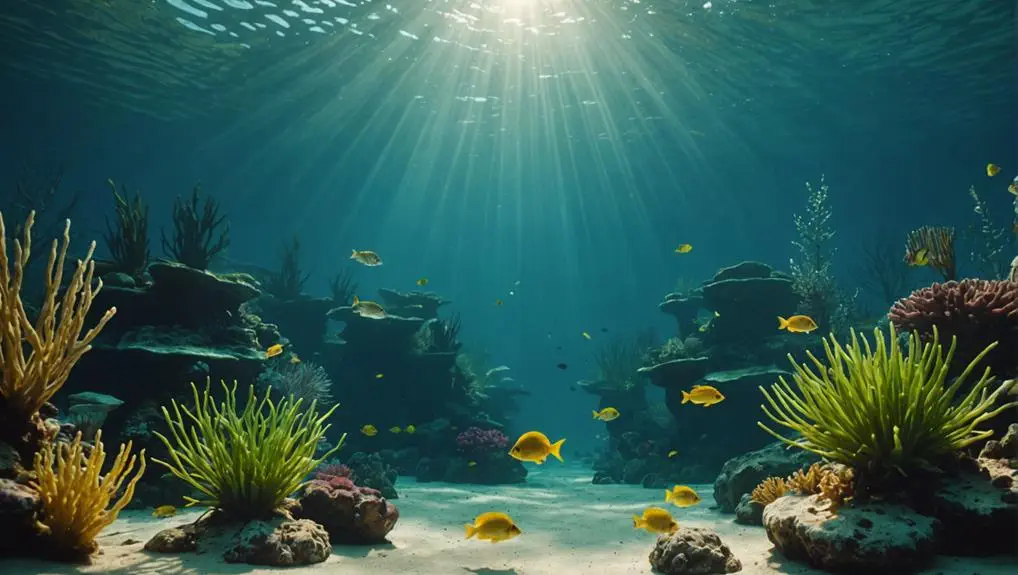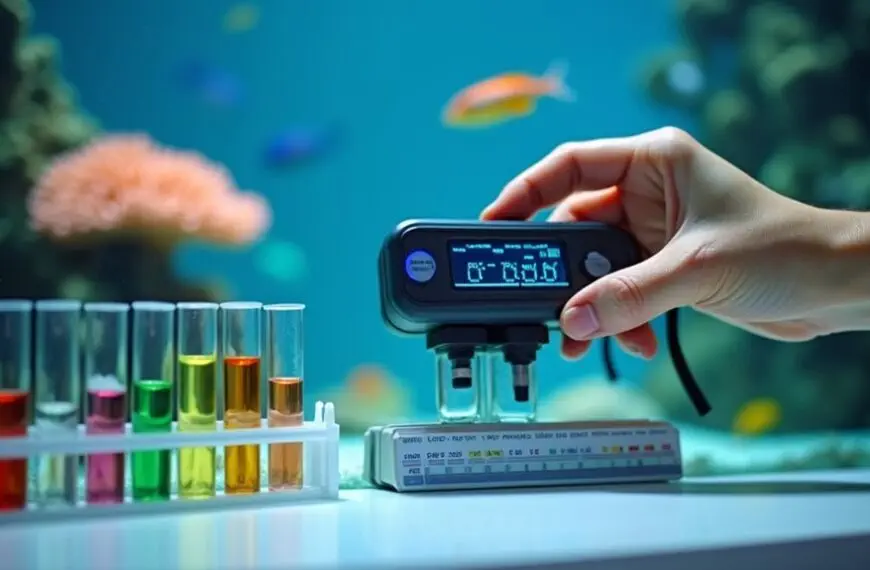Temperature is a big deal for your fish and their water quality! When water warms up, it holds less oxygen, making it tough for fish to breathe. Plus, fish metabolism speeds up with heat, meaning they need even more oxygen, leading to stress and health issues. You might also see changes in fish species, as warmer water attracts different types, scrambling the neighborhood dynamics. Not to mention, rising temps can stir up harmful algae blooms, which is like inviting the wrong party to your pond! Stick around, and you'll discover even more fascinating impacts of temperature on fish health!
Contents
Temperature and Dissolved Oxygen
When it comes to water quality, temperature plays a crucial role in dissolved oxygen levels. You mightn't realize it, but warmer water makes it harder for fish and other aquatic creatures to get the oxygen they need.
Cold water holds more dissolved oxygen, so as temperatures rise, oxygen depletion can quickly lead to hypoxic conditions. This is especially tough for cold-water species like trout, who thrive in cooler waters.
As temperatures climb, fish's metabolic rates increase. They use more oxygen, which can add stress to already low dissolved oxygen levels. Think of fish like us needing to catch their breath during a workout; it's tough when there's not enough oxygen available!
When oxygen levels dip, fish health can suffer, affecting their behavior and even their ability to reproduce. This disruption doesn't just impact one fish; it sends ripples through entire aquatic ecosystems.
So, if you're passionate about helping our waterways thrive, understanding how temperature affects dissolved oxygen is a great place to start.
Let's work together to keep our aquatic friends happy and healthy!
Effects on Fish Metabolism
Rising temperatures significantly impact fish metabolism, forcing them to adapt to changing conditions. As water temperatures increase, fish metabolism ramps up, often doubling for every 10°C rise. This means your finned friends have to work harder just to keep up!
Here are three key effects you should know about:
- Increased Respiration Rates: Warmer water means fish breathe faster, which makes them crave more dissolved oxygen. Unfortunately, higher temperatures can make oxygen scarcer.
- Metabolic Rate Changes: The Standard Metabolic Rate (SMR) rises with temperature, pushing fish to expend more energy for basic functions. But, there's a catch—after reaching their maximum metabolic performance (MMR), efficiency starts to decline.
- Stress in Fish: Temperature changes can lead to stress in fish, impacting their ability to thrive. They may become more vulnerable to diseases and environmental toxins, like a fish on a rollercoaster ride!
Understanding these effects helps you create a healthier environment for your aquatic pals. Keeping their water temperatures within the optimal range ensures they stay happy, healthy, and ready to swim!
Species Distribution Changes
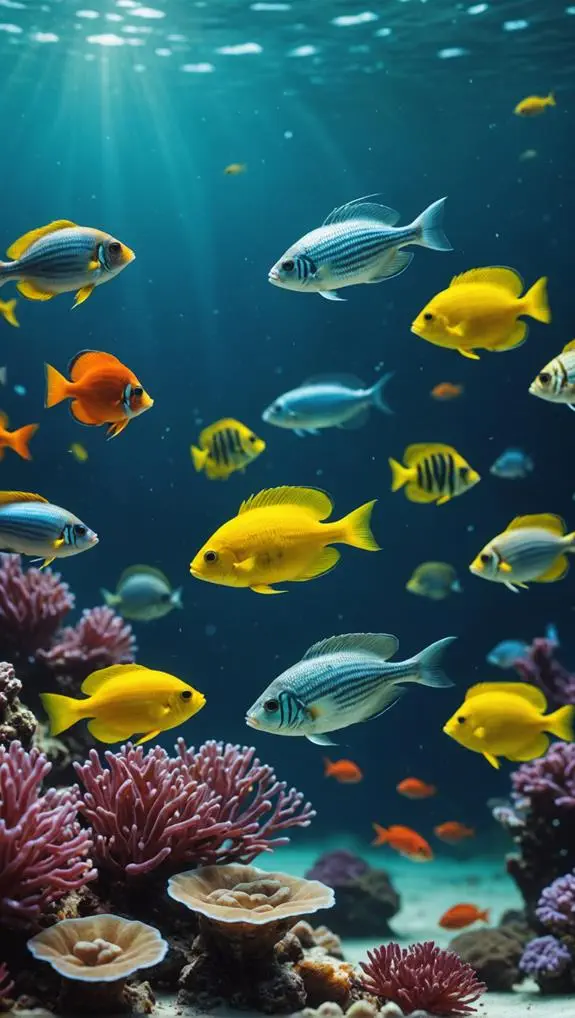
As temperatures climb, the distribution of fish species shifts dramatically. You might find it surprising how much warmer water temperatures can affect our aquatic friends. Cold-water fish, like brook trout, struggle as their habitats decline and they face longer journeys to find suitable spawning grounds. This makes their reproduction even trickier!
Meanwhile, increased temperatures invite warm-water species to the party, leading to competition that pushes native fish into less ideal spots.
But that's not all. When warmer temperatures reduce oxygen levels, the fish that can handle low oxygen thrive, which changes the community compositions in our waters. Suddenly, you're not just dealing with a few finned friends; the whole neighborhood is reshaping itself!
Temperature fluctuations of more than 5°C can send cold-water fish scuttling for cooler digs, causing regional shifts in species distribution.
And let's not forget about eutrophication, which causes those pesky algal blooms. They can outcompete native species for resources, leading to decreased biodiversity.
Impact on Nutrient Cycling
When it comes to nutrient cycling in our waters, temperature plays a huge role in how everything works.
Warmer water can speed up the breakdown of organic matter, releasing nutrients like nitrogen and phosphorus that fish need, but it can also cause those pesky algal blooms that suffocate our aquatic friends.
Temperature and Nutrient Availability
Temperature plays a crucial role in nutrient availability within aquatic ecosystems. When temperatures rise, nutrient cycling speeds up, but this can come with some serious side effects.
For instance, warmer temperatures enhance the solubility of nutrients like nitrogen and phosphorus. This can lead to robust phytoplankton growth, which sounds great, but it can also cause problems, such as eutrophication.
Here are three key points to consider:
- Increased Nutrient Overload: Warmer waters can lead to nutrient overload, causing harmful algal blooms.
- Dissolved Oxygen Levels: Higher temperatures often reduce dissolved oxygen levels, which aquatic organisms need to thrive.
- Microbial Activity: Warmer conditions boost microbial activity, increasing decomposition and releasing even more nutrients into the water.
These shifts can create a tricky situation. Eutrophication fosters conditions that lead to hypoxia, reducing available habitat and food sources for fish and other organisms.
So, while you might think warmer waters are a good thing, they can create a ripple effect that disrupts the balance in aquatic ecosystems.
Let's keep our waters healthy for all the aquatic creatures depending on them!
Oxygen Levels and Cycling
Warmer waters create a significant challenge for oxygen levels in aquatic environments, directly impacting nutrient cycling. As temperatures rise, the solubility of dissolved oxygen drops, leading to hypoxic conditions that can be tough on our fish friends.
Imagine trying to breathe through a straw while running a marathon—it's a little like that for fish when oxygen is scarce.
At these higher temperatures, fish also have increased metabolic rates, meaning they need more oxygen to keep swimming and thriving. This demand can outpace the available oxygen, creating a real struggle in aquatic ecosystems.
Plus, warmer waters speed up the decomposition of organic matter, which can lead to nutrient runoff. Unfortunately, this often contributes to harmful algal blooms that further reduce oxygen levels in the water.
When oxygen levels dip, it can disrupt the delicate balance of fish populations, causing declines in sensitive species.
This ripple effect can impact entire food webs, making nutrient cycling even more challenging. So, keeping our waters cool and oxygen-rich is crucial for healthy aquatic ecosystems and the fish that call them home!
Let's work together to protect these vital habitats for future generations.
Algal Bloom Dynamics
Harmful algal blooms (HABs) can drastically alter nutrient cycling in aquatic ecosystems, creating a challenging environment for fish and other organisms. As temperatures rise, these blooms thrive, leading to intense competition for oxygen and nutrients.
Here's how temperature impacts nutrient cycling:
- Increased Growth: Warmer water accelerates algal bloom growth, consuming nutrients rapidly.
- Oxygen Depletion: When blooms die off, they decompose, sucking up oxygen and risking fish kills.
- Nutrient Imbalance: The cycle of nutrient depletion and excess can disrupt the balance in water bodies.
Climate change is making these blooms more frequent and intense, which means you might notice more green scum on your favorite fishing spot.
This not only affects fish health but also the overall ecosystem. The breakdown of organic matter at higher temperatures can release even more nutrients, creating a vicious cycle.
Chemical Interactions and Toxins
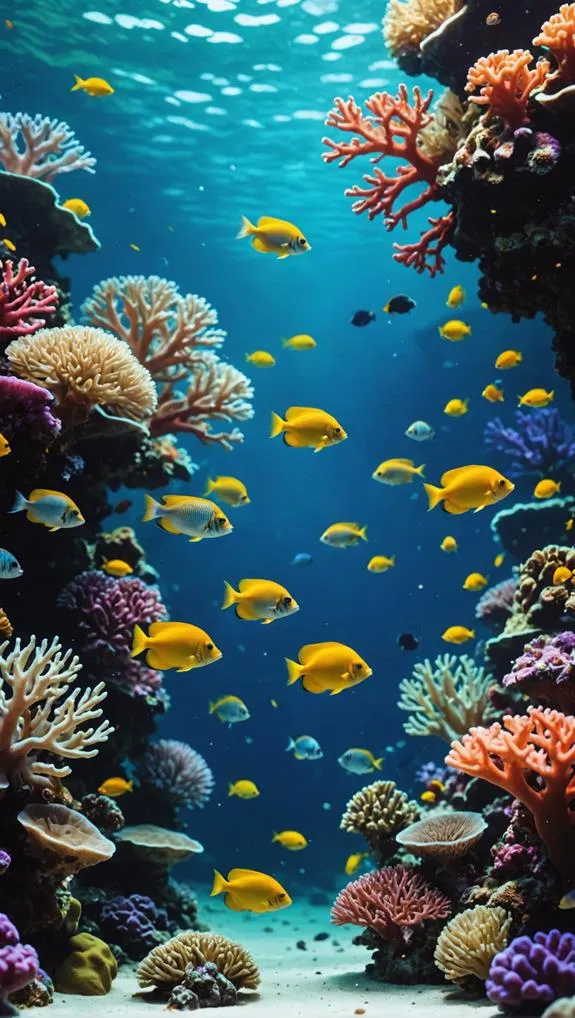
When temperatures rise, the water can turn into a toxic soup, making harmful substances like cyanides and phenols even more dangerous for fish.
Imagine your favorite fish struggling to survive while pollutants like copper from pesticides mess with their senses—no one wants that!
Toxin Solubility and Temperature
Temperature plays a crucial role in the solubility of various toxins in aquatic environments, directly impacting fish health.
When waters heat up, it creates a double-edged sword. Higher temperatures decrease the solubility of oxygen, forcing fish to work harder to breathe, which can lead to increased metabolic stress.
Meanwhile, the solubility of harmful substances like cyanide and phenol skyrockets, making life for fish pretty tough.
Here are a few ways temperature affects toxin solubility:
- Increased Contaminant Levels: Warmer waters can boost the concentration of toxic substances, increasing their toxicity.
- Harmful Algal Blooms: Elevated temperatures encourage algal blooms, which release even more toxins into the water.
- Stress on Fish: As the water warms, fish must deal with both the lack of oxygen and increased toxicity, leading to compromised health and survival.
Chemical Reactions and Fish
As aquatic environments warm, the chemical interactions between toxins and fish become increasingly complex and dangerous. Higher temperatures boost the solubility and toxicity of harmful substances like cyanides and phenol, which can really mess with fish health and survival.
Imagine your favorite fish gasping for air because warmer water can't hold enough dissolved oxygen. It's a tough situation, leading to heightened oxygen demands and potential respiratory stress.
On top of that, pollutants like heavy metals become more toxic when it's hot, further overwhelming fish's ability to cope. With temperature fluctuations, these stressors can team up, creating a perfect storm for our aquatic friends.
And let's not forget that some fish have specific temperature limits. For example, trout eggs can't hatch if it's too warm—above 14.4°C! This shows how temperature impacts not just survival but also reproductive success.
Habitat Alterations and Ecosystem Balance
Habitat alterations significantly disrupt ecosystem balance, especially in aquatic environments. When water temperatures rise, it influences fish in ways you mightn't expect. Increased metabolic rates lead to higher oxygen demands, which can cause dissolved oxygen depletion. This isn't good for our finned friends!
Here are three key impacts of habitat alterations:
- Habitat Loss: Warmer temperatures shrink the habitats for cold-water fish like brook trout, allowing warmer-adapted species to take over. This shift can upset the delicate balance of the ecosystem.
- Stress Responses: Sudden temperature changes—even just 5°C—can stress fish out. This affects their behavior, reproduction, and survival, sending ripples through the entire food web.
- Nutrient Cycling: Elevated temperatures speed up the breakdown of organic material. This accelerates nutrient cycling, often leading to harmful algal blooms that deplete oxygen further and harm aquatic ecosystems.
Strategies for Water Quality Maintenance
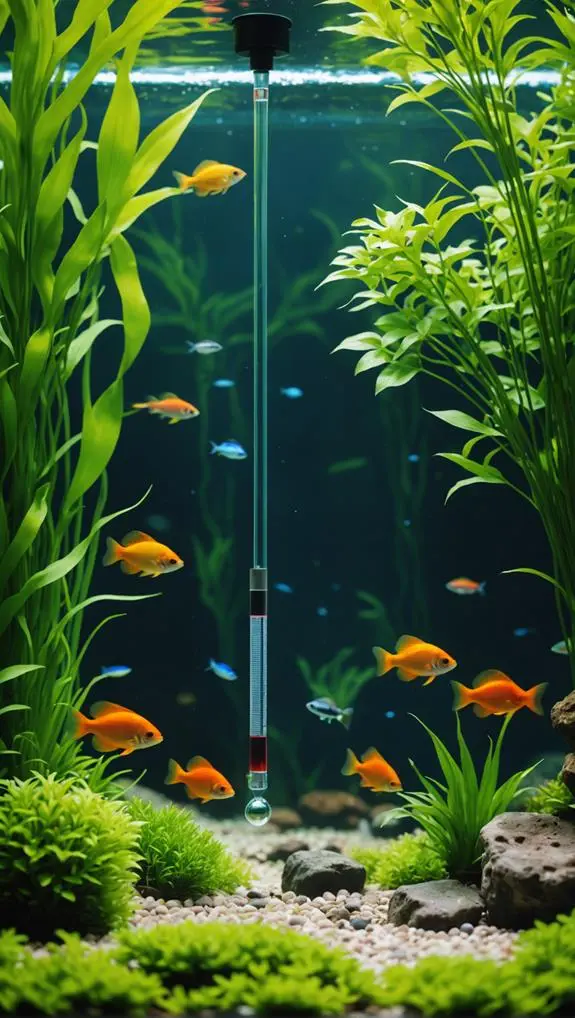
To maintain optimal water quality for fish, it's essential to implement effective strategies that address the challenges posed by rising temperatures.
First things first, you'll want to install temperature sensors to keep an eye on those water temps. A little monitoring goes a long way in ensuring your aquatic friends are happy and healthy.
Next, if you haven't already, consider adding aeration systems. These nifty devices can boost oxygen levels, especially during those hot summer months when fish feel the heat—literally! By keeping oxygen levels up, you're helping your fish avoid stress and potential health issues.
Don't forget about the environment around your water source! Enhancing vegetative buffers can cut down on nutrient runoff, which is a major culprit in raising water temperatures and encouraging harmful algal blooms.
Frequently Asked Questions
How Does Temperature Affect Water Quality?
Temperature affects water quality by influencing dissolved oxygen levels, pH levels, and metabolic rates. It can increase bacterial activity, alter nutrient cycling, cause thermal stratification, and promote harmful algal blooms and sedimentation processes, harming aquatic life.
What Does Temperature Change Do to Fish?
Temperature changes trigger tumultuous transformations in fish behavior, increasing metabolic rates while impacting oxygen levels. Stress responses and altered breeding cycles disrupt migration patterns, forcing species adaptation and shifting habitat preferences for survival in warmer waters.
Why Is Colder Water Better for Fish?
Colder water supports cold water species by enhancing oxygen solubility and stabilizing metabolic rates. It reduces stress levels, aligns with their spawning habits, habitat preferences, and breeding cycles, promoting healthier ecosystems for everyone involved.
How Does Temperature Affect an Aquarium?
Temperature affects your aquarium by influencing fish behavior and species compatibility. It impacts filter efficiency and algae growth, so maintaining temperature stability with proper heating equipment is crucial, especially during seasonal fluctuations for successful aquarium maintenance.
Final Thoughts
So, the next time you think about fish and water quality, remember: temperature's like that cranky roommate who can't stand the heat! It affects oxygen levels, metabolism, and even where fish decide to hang out. Keeping our waters cool and balanced is crucial for keeping our aquatic buddies happy. With a little effort, you can be a hero for fish everywhere—making sure they thrive rather than just survive. Let's keep those waters in tip-top shape together!

